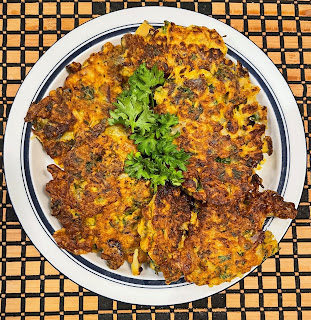Cauliflower
Dieticians have been singing praises for members of the Cruciferous vegetable family that include cabbage, Brussel sprouts, kale, broccoli and collards, for years. Only relatively recently such focus has also included cauliflower, which pales in contrast to the vibrant green of the other members. Nevertheless, it contains equally high levels of vitamins, nutrients and fiber, even if the head or ‘curd’ lacks chlorophyl.
It was recognized as a palatable addition to the table by the Romans in the first century, favored in Cyprus in Middle ages and was finally presented to Europe and the rest of the world in the 16th century, by who else than a French chef, naturally in the culinary form. The large white heads need somewhat fastidious growing conditions, hence their slow advance in popularity in the northern climes.
The firm texture of the fresh florets makes them a star for the vegetable tray and allows them to be roasted or quick fried for added flavor. Most familiar are the white varieties, but recently you can also find Italian cauliflower varieties in yellow and light purple, which unlike blue beans retain their color when cooked.
Cauliflower’s firm texture also allows it to be used in tasty soups or baking, as a healthy, low calorie (only 25 calories/cup) vegetable ingredient.
Cauliflower soup with Linguica breadcrumbs
Trim and separate 1 very large head of cauliflower in 2-inch florets.
Melt 3 tblsp. butter in a 3 qt. pot and sauté 1 onion and 2 stalks celery, coarsely diced, with 3 sliced garlic cloves for 5 minutes. Stir in 1 ½ tsp. dried thyme, 1 bay leaf and 6 cups chicken broth. Add the cauliflower florets, bring to boil and cook covered over moderately low heat for 30 minutes.
Cool the soup lightly, remove the bay leaf and purée in a blender in batches. Return blended soup to the pot, stir in 1-2 tblsp. white balsamic vinegar (optional), adjust seasoning with salt and pepper. If you like a creamier textured soup, stir in ½ cup heavy cream. Serve, sprinkled with Linguica breadcrumb topping.
Topping: in a skillet, cook 3 oz. chopped Linguica 2-3 minutes to crisp. Stir in ¾ cups panko and continue to cook for about 5 minutes until the crumbs brown and are crisp.
Cauliflower and Kimchi fritters
Baked and fried dishes with cauliflower require crushed cauliflower florets. This can be done either by grinding the florets in a Cuisinart, or for chunkier texture, briefly boiling them and mashing them with a fork or a potato masher.
Break off 4-5 cups cauliflower florets in 2-inch chunks from the tough stem and boil in salted water 4-5 minutes. Drain, reserving ½ cup of the water and mash the florets with a fork.
Beat 2 eggs in a large bowl, stir in: 1 tblsp Worcestershire sauce, 1 tsp. cumin, ½ tsp. turmeric, ¼ tsp. red pepper flakes, 1 tsp. salt, ½ cup cauliflower water and ½ cup all-purpose flour, mixing thoroughly. For a gluten free dish use rice flour. Now stir in 1 small finely chopped onion, ¼ cup chopped parsley, the cauliflower and 1 cup chopped kimchi with some liquid. When thoroughly mixed, fry in batches in 2 tblsp. hot olive oil 2 minutes on each side. Drain on paper towels. Makes about 6 large fritters.
Serve warm for lunch or dinner with sour cream, creamed cottage cheese, Greek tzatziki sauce or even Ranch dressing.
Never underestimate the versatility of cauliflower, one of the showier members of the Brassica family.
(I. Winicov Harrington lives in coastal Maine and is the author of “How to Eat Healthy and Well for Less than $5.00 a Day: the Smart-Frugal Food Plan”; website: www.winicov-harrington.com)


